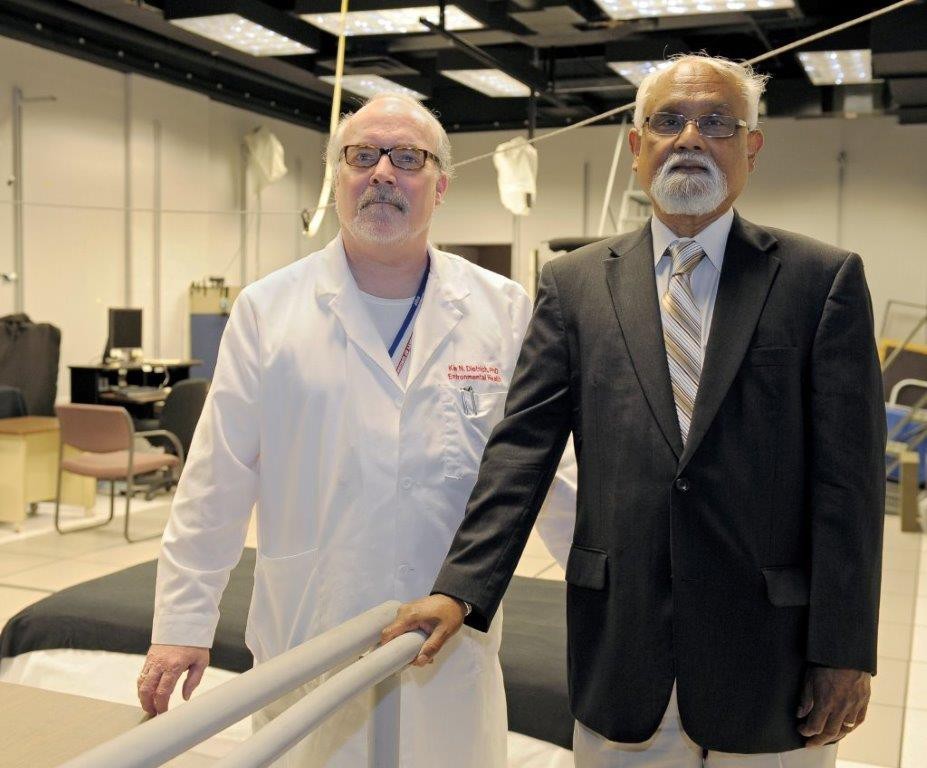
Researchers to Study Effects of Lead Exposure in African-American Women
CINCINNATIResearchers in the University of Cincinnati (UC) College of Medicines Department of Environmental Health have received a $2.35 million federal grant to study the effect of childhood lead exposure on bone and musculature health later in life in African-American women.
The grant, totaling $2,354,927 over four years, is from the National Institute for Environmental Health Sciences (NIEHS), an institute of the National Institutes of Health (NIH). Amit Bhattacharya, PhD, and Kim Dietrich, PhD, both professors in UCs environmental health department, will lead the study.
Bhattacharya and Dietrich are veteran collaborators on the effects of lead in the body through the Cincinnati Lead Study, a long-term prospective investigation of prenatal and postnatal lead exposure initiated in 1979 by researchers at the University of Cincinnati College of Medicine, Department of Environmental Health and the Cincinnati Childrens Hospital Medical Center. With continuous funding from the National Institute of Environmental Health Sciences, it is the longest-running prospective study of the effects of lead on health and development in the world.
Information gathered from the Cincinnati Lead Study has positioned UC environmental health faculty as influential leaders in lead-related research and efforts to prevent and treat lead exposure in the U.S. and worldwide, with their work contributing to multiple downward revisions of "level of concern lead levels by the U.S. Centers for Disease Control and Prevention.
Bhattacharya and Dietrich say that with the aging of the U.S. population, now is the time to assess risks of childhood lead exposure for older adults.
"This study is designed to provide, for the first time, transformative knowledge about how childhood history of environmental lead exposure affects bone and musculature health later in life among African-American women, says Bhattacharya. "Our hypothesis is that detrimental changes in bone and muscular parameters associated with early lead exposure could predispose African-American women collectively to greater risk of early osteoporosis and falls compared to persons with no or lower lead exposure.
The Cincinnati Lead Study has followed 376 male and female infants born in high-risk areas of Cincinnati between 1979 and 1984. Most are now at or approaching bone maturation age (28 to 32 years). Researchers will compare CLS subjects bone health, including such factors as mineral density, energy absorption capacity and postural instability, with that of healthy subjects within the CLS age range.
About 120 female subjects will participate in the new study. Dietrich notes that participation in the study by the original subjects has been sustained at high levels throughout its history, an accomplishment he credits to strong interpersonal relationships and caring research assistants.
A crucial assessment tool in the study will be patented technology developed by Bhattacharya and his former UC colleague, Nelson Watts, MD, called Bone Shock Absorbance (BSA), which uses small sensors called accelerometers attached to the subjects bony prominences to measure how energy from a heel strike is absorbed and dissipated through the musculoskeletal system. Information obtained through the painless, non-invasive BSA test is used to assess risk of fragility fracture associated with osteoporosis and represents a significant advance over the current method of using bone mineral density measured with DXA technology which uses low levels of radiation.
While blood lead concentrations in the U.S. population have declined since the discontinuation of lead as a gasoline additive, lead sequestered in bone continues to be a source of internal exposure for millions of peopleespecially minorities exposed to moderate to high levels of lead during their formative years by virtue of lead residues from paint in older and sometimes poorly maintained residences.
"African-Americans are historically more likely to live in inner cities than whites, and lower-income, inner-city children remain particularly vulnerable to lead exposure, says Dietrich.
Adds Bhattacharya: With this study, we take another step toward completing the circle of research through the Cincinnati Lead Study and hopefully helping this cohort and many others.
Watts, who was founding director of the UC Bone Health and Osteoporosis Center, is an osteoporosis expert consultant on the grant. Other collaborators are Heidi Kalkwarf, PhD, UC professor of pediatrics, principal investigator of the Cincinnati Childrens Hospital Medical Center subcontract on the grant, and David Chettle, PhD, professor of medical physics and applied radiation sciences, McMaster University, Hamilton, Ontario, principal investigator of the McMaster University subcontract.
The grant is titled, "Early Pb exposure a risk for bone health later in life in African American women (R01-ES024074-01).
Related Stories
Is ketamine the answer to treatment-resistant depression?
May 16, 2024
The University of Cincinnati's Stephen Rush joined WVXU's Cincinnati Edition to discuss the use of ketamine and esketamine to treat treatment-resistant depression.
UC study: Severe ischemic strokes rare in total patient...
May 15, 2024
The University of Cincinnati’s Yasmin Aziz will present research at the European Stroke Organisation Conference that found severe ischemic strokes with the most severe damage are rare in the total stroke patient population.
Increasing syphilis cases highlight treatment barriers across...
May 14, 2024
The University of Cincinnati's Carl Fichtenbaum spoke with the Cincinnati Enquirer about a recent report that found Hamilton County syphilis cases reached a six-year high in 2023.
